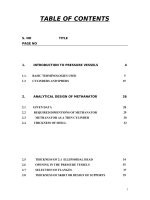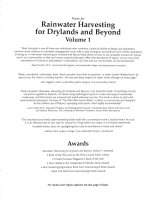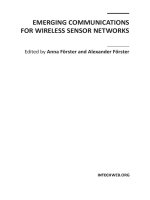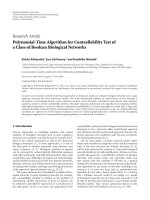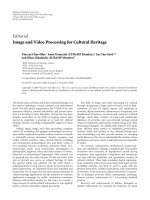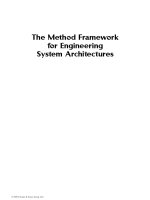METHOD STATEMENT FOR PRESSURE TEST ( MONG DUONG 1)
Bạn đang xem bản rút gọn của tài liệu. Xem và tải ngay bản đầy đủ của tài liệu tại đây (433.79 KB, 21 trang )
FOR INFORMATION
A
Dec 17, 2012
Issue for Information
REV.
DATE
DESCRIPTION
Y.J.Heo
Y.T.Lee
J. Son
DSGN
CHKD
APPD
PROJECT :
TWO(2) x 500 MW MONG DUONG 1 THERMAL POWER PLANT
EMPLOYER :
CONSULTANT :
CONTRACTOR :
DESIGNED BY
Y.J.Heo
CHECKED BY
Y.T.Lee
APPROVED BY
J. Son
DATE
Dec 17, 2012
DATE
Dec 17, 2012
TITLE :
METHOD STATEMENT FOR
PRESSURE TEST
DATE
PROJECT NUMBER
DOCUMENT NUMBER
REV.
Dec 17, 2012
ADB/MD1-TPIP/EPC150911
MD1-0-T-054-05-00195
A
Doc No.: MD1-0-T-054-05-00195
METHOD STATEMENT FOR
PRESSURE TEST
Rev. A
Page 2 of 17
Mong Duong1 Thermal Power Plant Project
METHOD STATEMENT
FOR
PRESSURE TEST
REV
DATE
DESCIPRITON
BY
CHECKED
APPROVED
A
Dec 17, 2012
ISSUE FOR INFORMATION
Y.J.Heo
Y.T.Lee
J. Son
METHOD STATEMENT FOR
PRESSURE TEST
Doc No.: MD1-0-T-054-05-00195
Rev. A
- TABLE OF CONTENT 1. Purpose
2. Scope
3. Reference Documents
4. Responsibility
5. Work Sequence
6. Inspection & Testing
7. Safety and First AID
8. Organization For Pressure Test
9. Attachment
Page 3 of 17
METHOD STATEMENT FOR
PRESSURE TEST
Doc No.: MD1-0-T-054-05-00195
Rev. A
Page 4 of 17
1. Purpose
The purpose of this procedure is to provide guidelines for pressure test (hydrostatic, pneumatic) of above
ground and underground piping to comply with project specification requirements
2. Scope
This method statement describes the instructions for general requirements of pressure test of piping
for the TWO(2) X 500 MW Mong Duong 1 Thermal Power Plant.
This method statement shall be read in conjunction with the related specifications, Code and
standards to ensure compliance with the project requirements.
3. Reference Documents
3.1 Reference Codes and Standards
ASME B31.1
:Power Piping
ASME Sec I
:Boiler and Pressure Vessel Code
ASME B31.3
:Process Piping
MD1-0-T-030-05-00072
:ITP for aboveground piping
MD1-0-T-030-05-00073
:ITP for underground piping
ERQ SEC 4.6
:Inspection and test
4. Responsibility
4.1 Piping Manager
The Piping Manager shall ensure that competent persons effectively implement this procedure.
4.2 QA/QC Manager
The QA/QC is responsible to ensure the quality of above scope of works.
4.3 Design Manager
Design Manager shall be responsible for the issuance of isometric drawings which is approved for
constructions and other relevant documents necessary for installing work.
METHOD STATEMENT FOR
PRESSURE TEST
Doc No.: MD1-0-T-054-05-00195
Rev. A
Page 5 of 17
4.4 Piping Engineer
The Piping Engineer shall perform installation of piping and field work for pressure test as per this
method statement.
5. Work Sequence
5.1 General execution
The test section of the line has been installed in accordance with approved drawings.
The welded joints of the test section shall be completed the visual inspection, applicable NDT,
PWHT and properly documented.
Location marking of test blind, gauge, isolation valves or temporary spools on the DWG.
Approval of test packages shall be secured before final pressure testing of the line.
Partial test of the line can be done in accordance with the approved drawing.
Vendor OEM and vendor recommendation shall be included in relevant test package.
Approved test packages shall be submitted for “walk down” inspections. Furthermore, if the lines
are cleared and ready for test, a written “Inspection Request” indicating the proposed date and
time shall be submitted to owner one day before the execution of pressure test.
The results of test shall be recorded on “Pressure Test Report” attached to the test package.
Ensure all the above ground piping spools, valves & other components installed as specified in
the given approved piping drawings.
Works shall be carried out in accordance with this method statement and project specifications.
All Equipments / Instruments shall have a valid calibration certificate and shall be recalibrated
before due date, Method statement shall be followed for calibration of Equipments / Instruments.
All piping systems to be hydrostatically tested shall be vented at the high points to remove air
from the system before applying pressure to the system.
All through valves shall be in fully opened position during pressure test.
All joints welded of flanged shall be uncovered for inspection during the test.
Pressure gauges used in testing shall be installed as close as possible to the lowest & highest
METHOD STATEMENT FOR
PRESSURE TEST
Doc No.: MD1-0-T-054-05-00195
Rev. A
Page 6 of 17
point in the piping system to be tested.
All pipe supports and anchors, including any temporary supports required due to weight of test
medium shall be installed prior to pressure testing. All spring-loaded pipe supports shall be
locked during hydrostatic testing. If any temporary supports need to be installed for pressure
testing, sketch or drawing of temporary supports approved by Engineering shall be attached in
the test package with isometric drawings.
An adequate Pressure Relief valve shall be provided on the test manifold to protect the piping
from overpressure. The pop test of pressure relief valve with 110% set pressure of test pressure
prior to hydro test shall be performed to ensure proper operation.
Prior to commencing pressure test, it shall be confirmed that any commitments of on-destructive
examinations, line check, etc. have been completed and equipment such as vessels, pumps and
instruments are isolated or removed from the piping by use of blinds or other suitable means.
Any manifold employed for pressure testing of piping shall be separately calculated and
pressure tested to the specified system test pressure before use. All manifold shall meet all
requirements as per Design code of the Permanent Piping and approved by engineering. An
isolation valve & Drain valve shall be provided between the manifold and the system being
tested.
METHOD STATEMENT FOR
PRESSURE TEST
Doc No.: MD1-0-T-054-05-00195
Rev. A
Page 7 of 17
Piping Walk-down Check List included in the Test Package shall be available for walk-down
prior to testing. Consolidated punch items will be categorized / classified as A, B and C items in
accordance with the following definitions
‘A’ Items to be completed/corrected prior to the hydrostatic test
Examples:
Not welded on pressure part such as butt joint, branch joint, shoe or anchor support
Not yet perform the NDE, if necessary
Not yet treat PWHT, if necessary
To be installed manual valves and proper supports which are born up the loading of
water
Non-pressure part welding such as structure steel to support, support to support
Certificate of pressure gauge, water analysis
Hydrotest PRV Calibration Certificate
‘B’ Items that can be completed after hydrostatic test
Examples:
Reinstatement point
In-line instrument item such as Relief valve, control valve, inline mixer, transmittal, etc
Interface with structural steel, cable tray, etc
‘C’ Items that can be completed/corrected during or after Initial Start-up.
Examples:
Touch up paint
Insulation work
METHOD STATEMENT FOR
PRESSURE TEST
Doc No.: MD1-0-T-054-05-00195
Rev. A
Page 8 of 17
Any punch items shall be recorded on the punch list in the pressure test package and
designated to the action discipline which is responsible to clear the punch item.
The classification of Punch list items should be agreed between HDEC and EVN as necessary.
The classification can depend on the future work-plans for the individual items of equipment and
system affected.
All weld joints which are to be taken NDE shall be confirmed by Contractor’s IPCS and attached
the Preheating/PWHT/NDE Summary in the hydro test package.
METHOD STATEMENT FOR
PRESSURE TEST
Doc No.: MD1-0-T-054-05-00195
Rev. A
Flow chart of pipe installation and pressure test
Fabricated spools at shop
Delivery to the laydown area
Inspection of spools as per
Isometric drawings
Painting
Delivery to the site
Site erection
Fit-up
Visual inspection for fit-up
Re-welding
YES
Preheating (If required)
Welding
NO
NDE
(If required)
Post Weld Heat Treatment
(If required)
Pressure Test
NO
Page 9 of 17
METHOD STATEMENT FOR
PRESSURE TEST
Doc No.: MD1-0-T-054-05-00195
Rev. A
Page 10 of 17
5.2 Preparation
Pressure Water Pump
Pressure Gauge
Manifold with relief valves and temporary piping or hoses
Manifold test certificate shall be provided in test package.
Verification of safety valve on line before test by HDEC Field Engineer.
Blind flanges with bolts/nuts and temporary gaskets.
Test Packages
5.3 Hydro Testing for GRP Pipeline
Before hydro testing, pipeline should meet the following conditions:
Construction is completed according to the design requirements.
System restraints such as thrust restraints, other supports and anchors are in place and properly
cured with the no deflects.
Pipe deflection within requirement limits.
It is suggested that the length of pipeline for hydro testing not more than 1 km. however
considering the system restraints and efficiency, the length can be longer.
Pressure gauge and thermometer for hydro testing should be calibrated and qualified for use.
Prior to testing, ensure no other foreign materials are found in the pipe. For larger diameter pipe,
workers can enter the pipe through inspection manhole to carry out the inspection and cleaning.
Wash the pipe with water if necessary.
Use suitable water source close to the testing site and ensure appropriate discharge locaton,
take note of the safety.
Testing plan is approved.
METHOD STATEMENT FOR
PRESSURE TEST
Doc No.: MD1-0-T-054-05-00195
Rev. A
Page 11 of 17
During Hydro testing:
Fill GRP pipeline with sea water or fresh water, open valves and vents to have the air removed
from the line during filling.
Pressurize the line slowly. Ensure the gauge location will be able to read the highest pipeline
pressure or make adjustment accordingly. Lower point will have higher pressure. Ensure the
pressure at the lower point does not exceed the bearing capability of pipe, meter and valve.
When the pressure reaches the testing pressure (1.5 times operating pressure), stop the pump.
Hold for 10minutes without any pressure drop. Then release the pressure to operating pressure
and hold for 20-30 minutes. Inspect the pipeline, if no leakages is noticed, the test is considered
successful.
During pressurizing process, if there are any leakages noticed, stop further pressurizing, mark
the leakage locations and carry out inspection. Ensure pipeline strength reliability before
continue pressurizing slowly to expose all the problems till reaching the testing pressure. Inspect
whether the leakages increase and any other new leakages found, mark all the leakage points,
record leakage patterns in order to analyze the causes and prepare for the repair proposal.
5.4 Hydrostatic Test for above ground piping
The HDEC Field Engineer will record all the activities such as elevating pressure, holding time,
decreasing time in order.
Hydrostatic testing of the line shall be using the potable or demi water. (Hydrostatic testing of
the stainless steel pipe line shall be using the demi water)
The testing pressure shall be 1.5 times for hydrostatic on the design pressure of the system.
Vent lines on the highest location of the test sections, are in open position during water filling to
allow elimination of air within the line.
The line is completely full if the water flows out from the vent lines. Let the water flow for a few
minutes to ensure that the air is completely eliminated within the line.
At the end of 1 hour holding time, verify the values of the pressure and transcribe these final
values in the minutes of testing.
In any case pipe insulation shall be carried out before hydrostatic test provided that all welded
joints shall be exposed for inspection during the test.
METHOD STATEMENT FOR
PRESSURE TEST
Doc No.: MD1-0-T-054-05-00195
Rev. A
Page 12 of 17
5.5 Pneumatic Test
The HDEC Field Engineer will record all activities in chart such as elevating pressure, holding
time, decreasing, etc.
Instrument and service air piping etc shall be subjected to air pressure test.
The testing pressure shall be 1.2 times the design pressure of the system.
The test medium shall be dry air or Nitrogen gas.
Flange connections and all threaded joints shall be checked for leaks using a soap solution test.
Compile a minute of testing and reporting the values of pressure from the beginning of the
testing.
At the end of 1 hour holding time, verify the values of the pressure and record the final values in
the minutes of testing.
5.6 Visual Test
Piping which is normally open to the atmosphere such as drains, vents, sewers piping, the last
shutoff valve etc. shall not be subjected to field pressure testing. Therefore, these lines are
subjected to visual inspection for acceptance.
5.7 Testing Medium
In general, test medium shall be potable water, which is free from all silt and non corrosive.
Stainless steel shall be tested using de-mineralized water, Test reports collected from HDEC
shall be attached with Hydro test record. Both test mediums and certificates which are
applicable to testing shall be provided by Company in accordance with Project specification. The
test medium temperature shall be 5℃ to avoid the possibility of brittle fracture.
METHOD STATEMENT FOR
PRESSURE TEST
Doc No.: MD1-0-T-054-05-00195
Rev. A
Page 13 of 17
5.8 Test Pressure
The hydrostatic test pressure which is calculated and approved by engineering shall be
indicated in the line list/test package.
The pressure difference between high and low positions of the test section shall be 1 bar per
10m.
Conversion of Hydrostatic head to Pressure
P=r X g X (h1-h2)
Where: P: Water head difference (N/m2 = Pascal)/ 105 = Bar
ρ: Water density (kg/m3)
g: Gravitational acceleration (9.8m/s2)
h: Static head (m)
* The Pressure of test section on the highest location will be decreased by 1 bar for every 10 m
from the lowest location of the test section.
5.9 Test Pressure Gauges
All gauges used for field testing shall have scale range of 1.5 to 4 times of the test pressure with
100mm dial.
All pressure gauge dials shall be in kgf/cm2
All pressure gauges shall be duly calibrated every six month as per Manufacturer's
recommendation using a standard dead weight gauge tester
METHOD STATEMENT FOR
PRESSURE TEST
Doc No.: MD1-0-T-054-05-00195
Rev. A
Page 14 of 17
5.10 Preparation of Test package
Test package shall include the following documents: Test report (Certificate), Line list with test
pressure, Certificates of Test gauge calibration and Water analysis, Mark-up P&ID and isometric
drawings as built, Welding inspection / Pre-heating / PWHT-NDT summary report, Piping Walkdown check list, Punch list, etc.
The IPCS will be used to determine the completion status of welds per isometrics in a test pack.
Test package has to be approved by HDEC prior to submitting to EVN to review.
5.11 Filling
Ensure suitable pumps are available for filling of the system and its pressurization. The
specification of pumps to be used shall be provided before testing.
Liquid testing medium shall be filled from the lowest point in the system to minimize the risk of
trapped air pockets.
After water filling and before pressurizing the line, supports shall be inspected for abnormal
movement, if any is found it shall be corrected before pressurizing.
5.12 Testing / Pressurizing
A minimum of two pressure gauges are required for the test system, one gauge shall be on the
test pump or test manifold and a minimum of one on the system being tested.
In line instruments such as control valves, orifice plate, flow meter, safety valve shall not be
included in the test system.
A pressure gauge shall be provided at the test manifold for guidance in bringing the system to the
required pressure.
Pressure shall be applied only after the system / line is ready and approved by company.
Pressure shall be applied by means of a pressurizing pump, which shall be disconnected from the
system and isolated by blind as soon as the test pressure is reached and the system is stabilized.
Piping systems shall not be pressurized at a rate exceeding 7 bars per minute.
After all punches are cleared and walk down is completed totally, the line shall be filled with water,
and shall be pressurized. After the pressure is built up to the required test pressure and
preliminary inspection by HDEC is completed, Company Inspectors shall be notified for final
inspection of the test section.
METHOD STATEMENT FOR
PRESSURE TEST
Doc No.: MD1-0-T-054-05-00195
Rev. A
Page 15 of 17
Pressure relief valves shall be set up adequately to avoid increase in pressure
PRV discharge shall be to safe location.
Care shall be taken to avoid increase in pressure due to temperature variation during the test by
monitoring the test pressure and releasing the same so as to maintain required pressure.
Test pressure and duration shall be maintained for at least 10 minutes after the pressure is raised
to the required test pressure and become stable to permit / allow for inspection of all joints for
leakage or signs of failure.
Any leakage found at the time of testing shall be marked, empty the line as the sequence of
draining fully or partially if necessary and make the repair. Then, the hydrostatic test shall be
repeated.
5.13 Draining
After successful completion of the test, the system shall be depressurized gradually and then
drain completely.
After the hydro-test has been completed, pressure shall be released in a manner and at a rate
so as not to endanger personnel or damage equipments.
De-pressurize the system through vent or flange “called vent.” Open manifold valves before
commencement of water draining to avoid negative pressure near the pump till gauge zero, then
open the vent valve.
When draining the systems after testing, vent valves at high point shall be opened before
opening drain valves to obviate vacuum arising in the system and possible resultant damage to
vessel, etc.
All vent and drains shall be opened before the system is to be drained and shall remain open till
all draining is complete so as to prevent formation of vacuum in the system.
Testing/draining of the system is completed, all temporary blanks and test blinds shall be
removed. All inline instruments, expansion joints, strainers, filter elements, and other
components removed or restrained for the test shall be reinstated when pre-commissioning
activities are completed.
Flanged connections, which are adjacent to temporary spool pieces, shall be reinstated with
new gaskets. And all temporary gaskets which are used in flange connection for hydrotest shall
be replaced with new ones. New bolts and nuts shall be provided as per bolting and torquing
procedure by qualified fitters if test bolting is not of correct grade for the service.
METHOD STATEMENT FOR
PRESSURE TEST
Doc No.: MD1-0-T-054-05-00195
Rev. A
Page 16 of 17
5.14 Acceptance criteria
The values of pressure shall be kept during the period of hydro test after the pressure is raised
to the required test pressure and becomes stable. No leakages are visible in any point of piping
system and no pressure decreases are occurred.
6. Inspection & Testing
Field Engineer shall notify QC Engineer for performing required inspection to assure that all
requirements are met.
All Inspection and Testing shall be performed in accordance with the Approved inspection and test
plan.
The last welding joint can be alternated 100% RT or UT in case of connecting each system
(equipment, pipe, valve etc.) which is completed pressure test.
Discipline Engineer shall notify QC Engineer for performing required inspection to assure that all
requirements are met.
All inspection and testing shall be performed in accordance with the approved inspection and test
plan. (MD1-0-T-030-05-00072, MD1-0-T-030-05-00073)
7. Safety and First AID
7.1 Safety Instructions
Do not smoke or use free flames anywhere close the jointing areas, under any circumstances.
Safety glasses and safety mask must be worn while grinding.
Closed areas, such as the inside of the pipe, or protected areas should be ventilated to avoid an
excessive inhalation of gas.
During the time when the pressure test is in progress, the area around the circuit under pressure
shall be cleared by authorized personnel and warning sign shall be installed before hydro test.
Patrols will also be provided to keep exclusion zone free of any unauthorized persons.
Any use of airline to blow off particles from pipe interiors, operator must wear groves, goggles
and a reducing nozzle must be pitted to the air hose.
PTW required – all other PTWs suspended.
METHOD STATEMENT FOR
PRESSURE TEST
Doc No.: MD1-0-T-054-05-00195
Rev. A
Page 17 of 17
7.2 First Aid
Excessive inhalation of vapor. Go out in the open air.
Ingestion. Induce vomiting and call for a doctor.
In case of fire use CO2, foam or powder extinguishers. Extinguishers must be within reach in the
working area in every moment.
Emergency contact during pressure test shall be arranged such as portable walkie talkie, and
mobile phone
8. Organization for Pressure Test
Prior to test, organization chart shall be checked and verified by HDEC field Engineer. The chart shall be
attached to test plan for verification and be checked by any HDEC field Engineer before filling the water
for test. Organization chart shall be revised for each package if relevant peoples are changed.
9. Attachment
Attachment #1: Check list before welding
Attachment #2: Welding inspection record
Attachment #3: Walk down inspection report before pressure test
Attachment #4: Pressure test report
Attachment 1
HYUNDAI ENG. & CONST. CO., LTD.
CHECK LIST BEFORE WELDING
TWO(2) X 500MW MONG DUONG 1 THERMAL POWER PLANT
ISO DWG. NO.:
SYSTEM:
P&I NO.:
LINE NO:
NO.
CHECK ITEM
1
Material Verification
2
Verifying WPS
3
Verifying Welder’s ID
4
Visual / Dimensional Check
5
Edge Preparation Inspection
6
Preheating(If required)
7
Heat Treatment(If required)
8
Others
RESULT
REMARK
REMARKS :
SIGNATURE
SUBCONTRACTOR
:
CONTRACTOR
:
EMPLOYER
:
DATE
FORM NO. ITP-P-100-01
Attachment 2
HYUNDAI ENG. & CONST. CO., LTD.
WELDING INSPECTION RECORD
TWO(2) X 500MW MONG DUONG 1 THERMAL POWER PLANT
ISO Drawing No :
Rev. No :
P&ID No :
Line No :
Joint No.
System :
Dia.
(㎜)
Welding
Sch.
Visual
NDE(RT/UT/MT/PT)
Welder No.
PWHT
Date
Fit-up
Final
Kind
Report No.
REMARK
Result
No.
SUBCONTRACTOR
CONTRACTOR
EMPLOYER
SIGN
DATE
FORM NO. ITP-P-100-02
Attachment 3
HYUNDAI ENG. & CONST. CO., LTD.
WALK DOWN INSPECTION REPORT BEFORE PRESSURE TEST
TWO(2) X 500MW MONG DUONG 1 THERMAL POWER PLANT
TEST PACKAGE NO.:
ISO DWG NO.:
P&ID NO.:
LINE NO.:
SYSTEM :
NO.
CHECK ITEM
RESULT
1
Material Verification
2
Correct Dimension, Location and Orientation
3
Welding Completed
4
NDE Completed
5
PWHT Completed
6
Valve, In-Line Item and Equipment Completed
7
Support and Hanger Installation
8
Others
REMARK
REMARKS :
SIGNATURE
SUBCONTRACTOR
:
CONTRACTOR
:
EMPLOYER
:
DATE
FORM NO. ITP-P-100-03
Attachment 4
HYUNDAI ENG. & CONST. CO., LTD.
PRESSURE TEST REPORT
TWO(2) X 500MW MONG DUONG 1 THERMAL POWER PLANT
TEST PACKAGE NO.:
ISO DWG NO.:
P&ID NO.:
LINE NO.:
SYSTEM :
DATE OF TEST:
TYPE OF TEST :
DESIGN PRESSURE / TEMP :
□ HYDROSTATIC □ PNEUMATIC □ OTHERS
REQUIRED TEST PRESSURE :
TEST MEDIUM / TEMP :
ACTUAL TEST PRESSURE :
PRESSURE GAUGE SERIAL NO.:
PRESURE HOLDING TIME :
MIN., START :
FINISH :
SKETCH OF TEST BOUNDARIES :
RESULT :
ACCEPT
REJECT
REMARK :
SIGNATURE
SUBCONTRACTOR
:
CONTRACTOR
:
EMPLOYER
:
DATE
FORM NO. ITP-P-100-04


